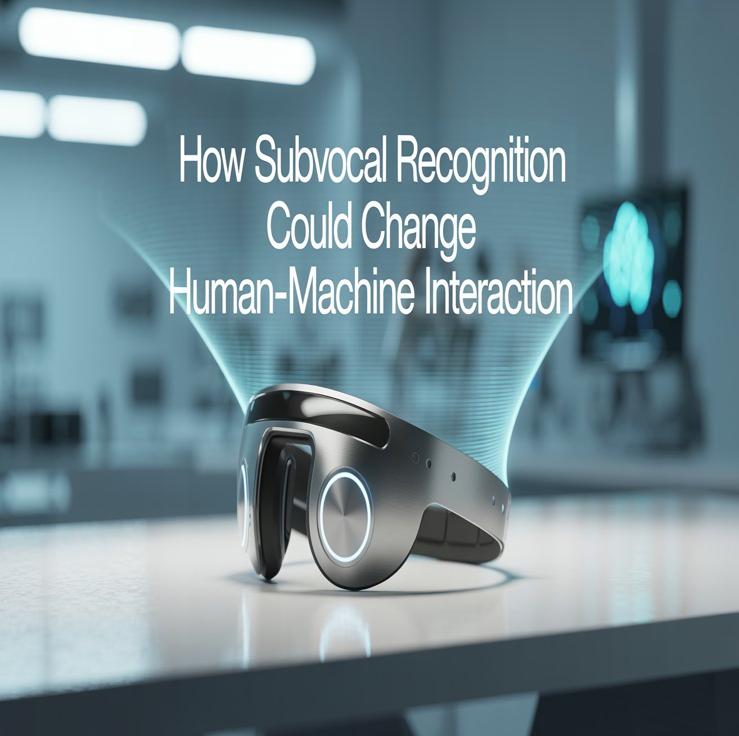How Subvocal Recognition Could Change Human-Machine Interaction
Reading Your Thoughts Without Speaking a Single Word
Introduction
Subvocal recognition is redefining the future of communication. By detecting internal speech—words we say silently in our minds—it enables devices to respond without spoken commands. This groundbreaking technology opens up possibilities for silent control, accessibility, and thought-driven computing in fields ranging from healthcare to defense and everyday personal technology.
Subvocal recognition is redefining the future of communication. By detecting internal speech—words we say silently in our minds—it enables devices to respond without spoken commands. This groundbreaking technology opens up possibilities for silent control, accessibility, and thought-driven computing in fields ranging from healthcare to defense and everyday personal technology.
The implications extend far beyond convenience. In critical situations—such as disaster response, surgical operations, or covert security missions—being able to issue commands without making a sound could be the difference between success and failure. Subvocal recognition allows for communication in environments where noise, privacy, or safety concerns make audible speech impossible, all while maintaining efficiency and discretion.
Moreover, this technology has the potential to reshape inclusivity in the digital world. People with speech or motor impairments could gain a powerful new tool for expression, enabling them to interact with technology in ways that were once unimaginable. As sensor accuracy improves and AI models grow more capable, subvocal interfaces could become as common as keyboards and touchscreens—ushering in an era where our thoughts are the most natural input of all.
What Is Subvocal Recognition?
Subvocal recognition is a way for computers or devices to understand the words you say silently in your head. Even if you don’t speak out loud, your brain still sends tiny signals to the muscles in your face, throat, and vocal cords—just like it would if you were talking.
Special sensors, placed on your skin (often on your jaw, neck, or throat), can pick up these tiny muscle movements. The most common method is called surface electromyography (sEMG), which can detect very small electrical signals from your muscles.
Unlike normal voice recognition, this technology doesn’t need sound at all. This makes it useful in noisy places, during private conversations, or in situations where you need to stay silent. It allows people to control devices or send messages without anyone hearing a word.
The Technology Behind the Silence
- Hands-Free, Voice-Free Interfaces
For individuals working in high-stakes environments—pilots, surgeons, or soldiers—subvocal interfaces allow them to issue commands or receive updates without breaking concentration or disturbing others. - Accessibility for Disabled Users
People with speech impairments or neurological conditions like ALS (Amyotrophic Lateral Sclerosis) can benefit immensely. Subvocal tech could provide a new voice for those unable to speak. - Augmented Reality & Virtual Reality
In immersive environments where using a keyboard or speaking aloud may not be feasible, subvocal recognition adds a layer of intuitive, silent control. - Mental Health & Cognitive Monitoring
Since subvocalization often reflects internal thoughts, future applications could include emotion detection, mental health monitoring, or focus analysis.
Challenges in Subvocal Technology
Even though subvocal recognition is exciting, it is still being developed and tested. One big challenge is that the signals are different for each person. This means the system might need to be trained separately for every user, which can take time. Right now, most systems also understand only a small number of words, so they can’t yet handle long conversations. Some people may also find the sensors uncomfortable to wear for long periods.
Another difficulty is that the technology struggles with complex sentences or strong accents in silent speech. Since everyone moves their mouth and throat muscles a little differently, the system needs a lot of training data to work well. This can make setup slower and more expensive, especially for large-scale use.
There are also privacy and ethics concerns. Some people worry that the technology could be used for “thought reading” without permission. While current systems can’t read random thoughts, they do detect internal speech—so rules will be needed to protect people’s privacy. Clear laws and guidelines must ensure users give consent, know what data is collected, and understand how it will be used.
Another concern is security. If subvocal commands are used to control important devices—like medical equipment or military tools—they must be protected against hacking or misuse. Developers will need to make sure the systems are safe, accurate, and only respond to the right person.
Finally, cost and accessibility could slow down adoption. High-quality sensors and training can be expensive, which might make the technology harder to access for everyday people at first. As the hardware becomes smaller, cheaper, and easier to use, subvocal recognition will have a better chance to reach more users around the world.
Global Interest and Investment
All over the world, many industries are exploring how to use subvocal recognition. Big technology companies want to add it to smartphones, computers, and smart home devices. Defense organizations see it as a safe way for soldiers to communicate silently during missions. Healthcare experts believe it could help people who cannot speak and make medical work more efficient.
In the United States, DARPA (Defense Advanced Research Projects Agency) is testing how the technology can be used for secure, silent communication on the battlefield. At the same time, small tech startups are working on consumer-friendly products for gaming, navigation, and daily productivity, making the technology more accessible to everyday users.
Countries such as the UAE and India are also investing in this area. Both have strong plans for AI innovation, smart city development, and modern healthcare. By combining subvocal recognition with inclusive technology projects and digital health platforms, they could make it a key part of the next wave of global innovation.


